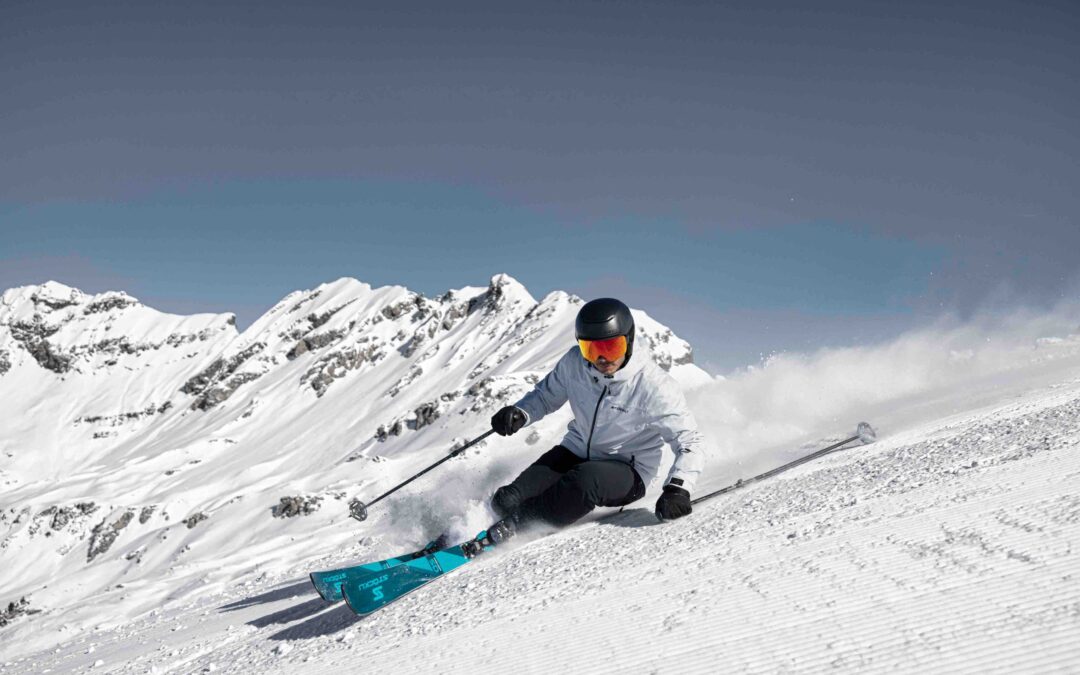Overview
Our spider sense tingles when we hear the term “handmade” applied to skis, as the implication is that such slats will receive extraordinary care in manufacture no mass-produced ski can hope to receive. One reason we look sideways at the “handmade” qualifier is that all adult skis are to some degree handmade and some processes – even at “handmade” plants – are best managed robotically. In fact, there’s no obligatory reason a “handmade” ski should be superior, or conversely, a “mass produced” model shouldn’t be exquisite. While the “handmade” handle hopes to convey scrupulous craftsmanship, it’s just as likely to be a euphemism for “inefficient production technology with slack quality control.”
Of all the brands that hang their hat on a handmade reputation, Stöckli represents the best of what we associate with the term and avoids all the potential pitfalls. Perhaps all we need to say is that it is Swiss to the core. If it is inefficient, it’s because it chooses to be; who else tinkers with its production several times mid-season as new ideas are tested and adopted? Sure, other brands are also refining their products throughout the year, but they don’t usually make such midstream improvements available to the public. But if Stöckli concocts a faster race ski, the next model it makes – whether for a racer or a consumer – will incorporate those improvements. If that sounds special, it is.
Stöckli doesn’t condescend to their buying public. It assumes if you want its race skis, you want the same race skis its World Cup athletes use, so that’s what you get. It doesn’t compromise on construction and the finishing steps applied to all Stöckli skis are state-of-the-art and beyond meticulous. Most companies would fire any engineer who recommended a method that took a week to produce a finished ski; at Stöckli, they’d probably promote him.
Stöckli’s willingness to try new technology is evident in the recent history of its top Laser and Stormrider models, its two most popular series in the U.S. A few years ago, it inserted polyamide strips in the top Titanal layer of four Stormrider models, only to remove them a year later because the inserts were hard to manage from a quality control standpoint. Apparently undaunted by manufacturing challenges, it co-created Turtle Shell Technology, which consists of S-shaped slits in Titanal laminates that are filled with an elastomer so they can be squeezed together under pressure. Turtle Shell tech comes in two versions, Turtle Shell Racing, with a deep notch in the thick base laminate for competition skis, and Turtle Shell Comfort, with a smaller gap in the top sheet for recreational models like the erstwhile Laser AX and Laser MX for women.
While it fair to say that Stöckli marches to the beat of its own drum, it’s not completely immune to market trends. It’s made an effort to lighten its Stormrider series over the years, and, perhaps grudgingly, has incorporated a touch of tip and tail rocker to its all-world off-trail models.
With the addition four years ago of the Laser AR, Stöckli bridged the gap between its Laser and Stormrider collections, moving its widest carver within 5mm (waist width) of its narrowest all-mountain model. At 83mm underfoot, the Laser AR is one of a cluster of new models that blur the distinction between on-trail and all-terrain models. In theory, an all-terrain ski would have more accommodations for powder-like conditions, but in practice a great many skiers with all-mountain skills spend upwards of 70% of their time on groomers. For them, a great carver like the Laser AR that won’t wilt in the face of a little loose snow is a more sensible option than a double-rockered fatty.
There was absolutely nothing wrong with the Laser AR and Laser AX, but that didn’t deter Stöckli from altering them last year anyway. To draw attention to the two models’ all-terrain chops and cut them out of the large pack of Laser race skis, Stöckli gave them their own model family, Montero. Their greater terrain versatility supposedly derives from a slight change in sidecut that takes some of the curvature out of their shape and adds a mm or two at the waist. The 84mm Montero AR also adopts the Turtle Shell tech already built into the 80mm Montero AX.
While the new Monteros aren’t behaviorally very different from their Laser forebears, the distinction between the AR and AX on snow remains genuine. The Montero AX likes its turns served shorter, and while it certainly won’t flounder in soft snow, neither does it feel the need to seek it out. The AR likes to run a little hotter and turns a blind eye to any terrain variability likely to be encountered in-resort. Both are Hall of Fame Frontside carvers with no discernable performance ceiling.
One reason Stöcklis aren’t more widely distributed in America is their elevated, and rarely discounted, prices, usually over $1,000 in a market stuffed with quality options at $800. If you can manage to swallow that hairball, you’ll discover why Stöcklis are the sort of skis you own for life.
The 2024 Season
Once Stöckli created the Montero family by plumping up the Laser AX and AR, it left a space in the narrow end of the this Frontside family for a more svelte sibling, a void filled this year with the Montero AS. The “S” is short for “Slalom,” and it’s 13.7m sidecut radius (166cm) proves this isn’t simply marketing bluster. Left to its own devices, it would crank out cat-quick arcs from dawn to dusk, a skiing style that isn’t exactly in its heyday on American pistes. It can be feathered into a longer turn, of course, but it’s crazy to get a ski this slalom-centric and then feed it a diet of GS turns. There’s also a new Montero for women, but its 80mm waist and less radical sidecut should be more turn-agnostic than the go-short-or-go-home Montero AS.

